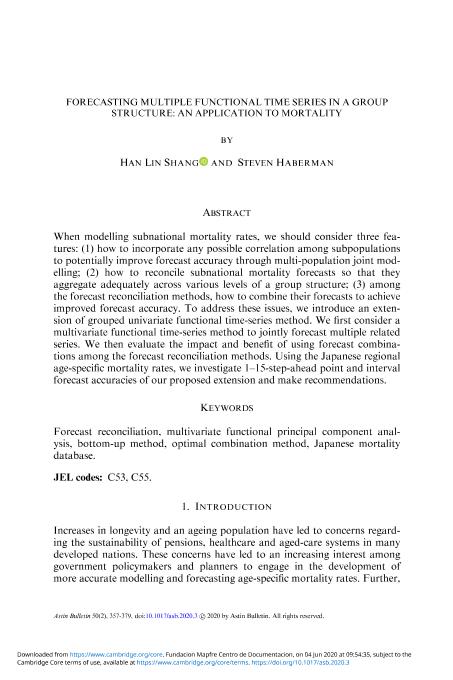Forecasting multiple functional time series in a group structure : an application to mortality

Contenido multimedia no disponible por derechos de autor o por acceso restringido. Contacte con la institución para más información.
| Tag | 1 | 2 | Value |
|---|---|---|---|
| LDR | 00000cab a2200000 4500 | ||
| 001 | MAP20200019053 | ||
| 003 | MAP | ||
| 005 | 20200604160052.0 | ||
| 008 | 200604e20200501bel|||p |0|||b|eng d | ||
| 040 | $aMAP$bspa$dMAP | ||
| 084 | $a6 | ||
| 100 | 1 | $0MAPA20190015141$aLin Shang, Han | |
| 245 | 1 | 0 | $aForecasting multiple functional time series in a group structure$b: an application to mortality$cHan Lin Shang, Steven Haberman |
| 520 | $aWhen modelling subnational mortality rates, we should consider three features: How to incorporate any possible correlation among subpopulations to potentially improve forecast accuracy through multi-population joint modelling; How to reconcile subnational mortality forecasts so that they aggregate adequately across various levels of a group structure; Among the forecast reconciliation methods, how to combine their forecasts to achieve improved forecast accuracy. To address these issues, we introduce an extension of grouped univariate functional time-series method. We first consider a multivariate functional time-series method to jointly forecast multiple related series. We then evaluate the impact and benefit of using forecast combinations among the forecast reconciliation methods. Using the Japanese regional age-specific mortality rates, we investigate 115-step-ahead point and interval forecast accuracies of our proposed extension and make recommendations. | ||
| 650 | 4 | $0MAPA20080592011$aModelos actuariales | |
| 650 | 4 | $0MAPA20080555306$aMortalidad | |
| 650 | 4 | $0MAPA20080552183$aPoblación | |
| 650 | 4 | $0MAPA20080568085$aBases de datos | |
| 650 | 4 | $0MAPA20080579258$aCálculo actuarial | |
| 651 | 1 | $0MAPA20080650919$aJapón | |
| 700 | 1 | $0MAPA20080165116$aHaberman, Steven | |
| 773 | 0 | $wMAP20077000420$tAstin bulletin$dBelgium : ASTIN and AFIR Sections of the International Actuarial Association$x0515-0361$g01/05/2020 Volumen 50 Número 2 - mayo 2020 , p. 357-379 |

